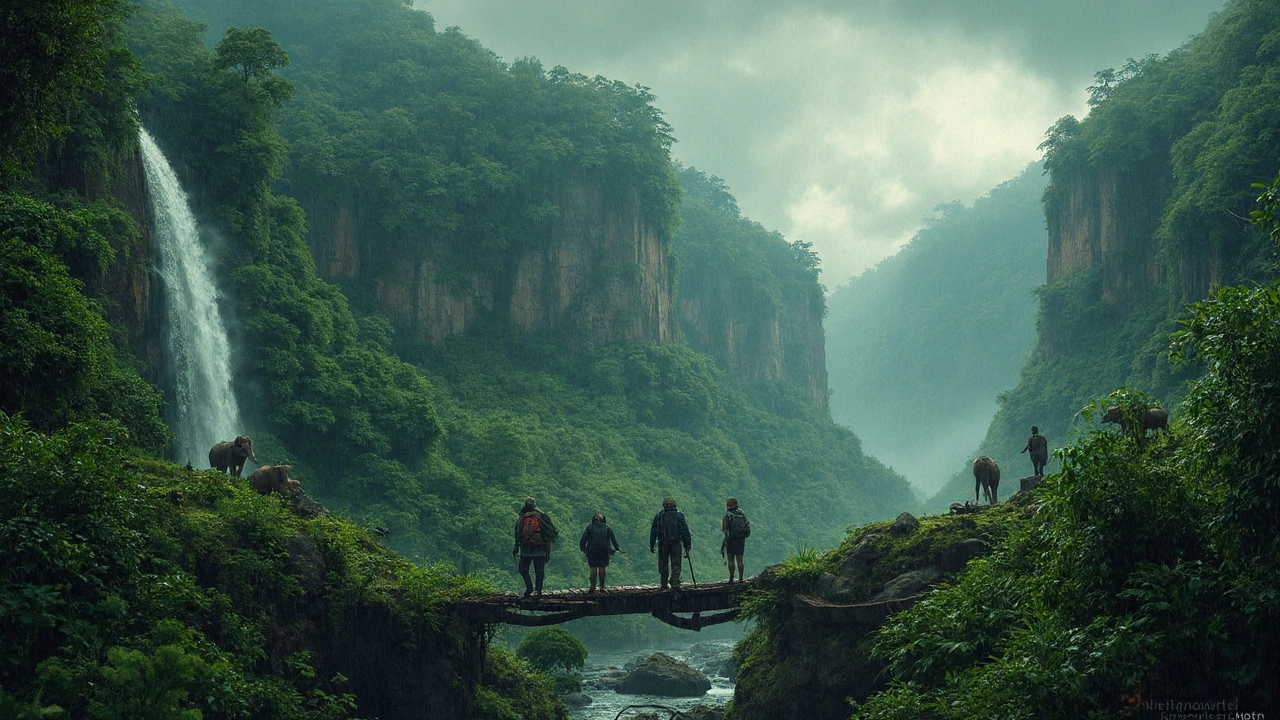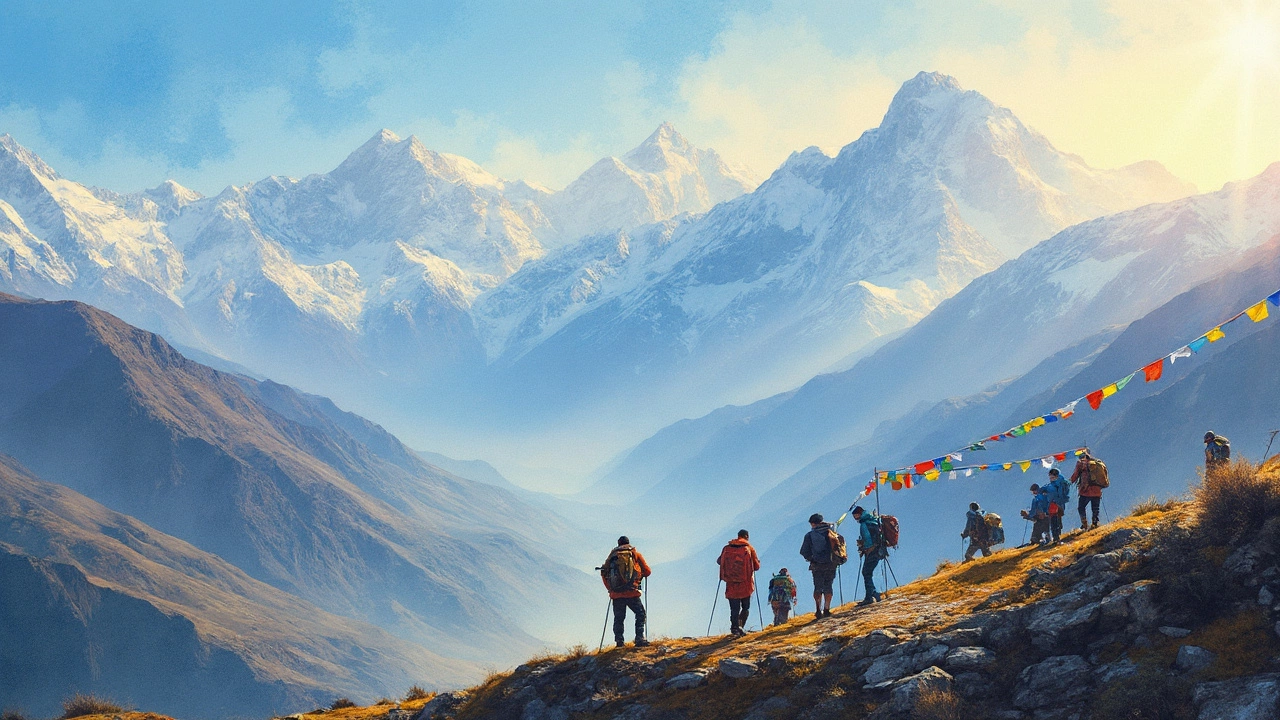When you think hiking, India's vast and varied landscapes promise an adventure like no other. Whether it's the breathtaking snow-capped peaks in the north or the lush green hills in the south, there's something for every hiker in this incredible country. But what makes India truly special are the endless opportunities to explore remote trails, ancient paths, and vibrant cultures.
First things first, if you're heading to the Himalayas, you're in for a real treat. This region is a trekker's paradise with towering peaks and dramatic landscapes. But remember, these trails are not for the faint-hearted, so a little prep goes a long way in making your trip smooth.
- The Himalayas: A Trekker's Paradise
- Western Ghats: Lush Trails
- Essential Hiking Tips in India
- Top Treks to Consider
- Best Time to Trek in India
- How to Prepare for Indian Trails
The Himalayas: A Trekker's Paradise
When it comes to trekking places that spark amazement, the Himalayas top the list. This massive mountain range isn't just for the experienced alpinists—there are trails for everyone. From day hikes to intense multi-day trips, it's all about finding the path that suits your energy and curiosity.
Iconic Treks to Try
Among the most popular routes, the Roopkund Trek stands out. Known for its mysterious skeleton lake, it offers an eerie yet enticing adventure. If you’re after stunning views, the Valley of Flowers trek is a must, where you can witness vibrant meadows enclosed by splendid peaks.
When to Go
Timing matters for these treks. The best time to explore the Indian Himalayas is usually between May and October. Outside these months, many trails may be covered in snow and quite treacherous.
What to Keep in Mind
Preparation is key. Bring the right gear and consider acclimatization if you’re hitting up high-altitude spots. Stay hydrated and pace yourself to avoid altitude sickness. Local guides can enrich the experience and keep you safe.
- Check weather updates before you go.
- Carry appropriate permits.
- Respect local communities and their customs.
Hiking in the best countries like India gives you bragging rights and stories to share. It's an experience that not only challenges your limits but also rewards you with the serenity and beauty of unspoiled nature.
Western Ghats: Lush Trails
Nestled along the western coast, the Western Ghats are a hiker's dream with their stunning greenery and rich biodiversity. This ancient mountain range stretches over 1,600 km, offering a variety of trekking routes that keep nature enthusiasts coming back for more.
Why trek the Western Ghats?
The region is a UNESCO World Heritage Site, known for its unique species of flora and fauna. Imagine trekking alongside lively streams, spotting rare birds, and catching glimpses of vibrant butterflies. It's not just about the beauty; the Western Ghats also hold precious ecosystems that support numerous wildlife sanctuaries and national parks.
Top Trails to Explore
- Kudremukh Trek: Located in Karnataka, this trek offers sweeping views of rolling hills and deep valleys. Known for its distinct horse-face shape, Kudremukh is ideal for those seeking moderate difficulty treks.
- Chembra Peak Trek: In Wayanad, Kerala, this trek is famous for its heart-shaped lake near the top. It's a short but rewarding hike with panoramic views that will leave you breathless.
- Rajmachi Fort Trek: Nestled between Lonavala and Khandala in Maharashtra, this trek offers a glimpse into fascinating historical sites amidst lush surroundings.
These trails cater to both beginners and seasoned hikers, providing an unforgettable mix of challenges and delights.
Useful Tips for Hiking Here
- Packing: Lightweight clothing and sturdy boots are a must. Don't forget your rain gear, as the region sees occasional showers.
- Best time to visit: To experience the western ghats at their greenest, visit right after the monsoon season, between September and March.
- Permits and Guides: Some areas require prior permits. A local guide can enhance your trek with interesting tidbits about the flora, fauna, and trails.
Enjoy hiking among nature's finest but remember to respect it—leave no trace, and take only memories.
Essential Hiking Tips in India
Heading out for a hike in India? You’re in for an adventure of a lifetime, but a bit of preparation can make all the difference. Here's what you need to know to ensure a safe and unforgettable trekking experience.
Plan Your Route Wisely
India's trails vary from beginner-friendly paths to challenging high-altitude treks. Knowing your fitness level and experience is crucial. For those just starting, the Western Ghats offer more accessible hikes.
Gear Up with the Right Equipment
Your shoes can make or break your trip! Invest in a good pair of hiking boots that offer support and grip. And don't forget to pack lightweight clothing in layers, as weather can change quickly, especially in the Himalayas.
Don’t Skimp on Hydration
Staying hydrated is key, so carry enough water and a filtration system if you plan to refill from streams. Dehydration can be sneaky, particularly at high altitudes.
Respect the Local Culture
India is rich in culture and traditions, even in remote areas. Take some time to learn basic greetings and respect local customs. It’s an easy way to show respect and enrich your experience.
Acclimatization is Crucial for High-Altitude Treks
Altitude sickness can hit anyone, regardless of fitness level. If trekking in the Himalayas, plan your itinerary to include rest days. It might feel slow, but it’s important for your health.
- Rest more if symptoms like headache or dizziness start.
- Consider acclimatization hikes before the main trek.
Stay Informed and Safe
Before heading out, check local weather conditions, and always let someone know your plans. Having a local guide can be invaluable, both for their knowledge and for safety.
| Item | Must Have |
|---|---|
| Hiking Boots | Yes |
| Water Bottle | Essential |
| First-aid Kit | Always Carry |

Top Treks to Consider
India's trekking scene is nothing short of spectacular, offering trails that cater to all adventure levels. Here's a breakdown of some top trekking places in the country:
1. Chadar Trek, Ladakh
The Chadar Trek is not for the faint-hearted. During winter, the Zanskar River freezes, creating a glassy path that reflects the icy beauty all around. This frozen river trek is a unique experience, mainly occurring in January and February. Ensure you’re prepared for the harsh cold and high-altitude conditions.
2. Roopkund Trek, Uttarakhand
Famous for the Skeleton Lake, where human skeletons from centuries ago lie around its edges, the Roopkund Trek is a thrilling journey. It's not just about the mysterious lake, though; you’ll trek through lush forests, alpine meadows, and snow stretches. Best time to visit: May-June and September-October.
3. Valley of Flowers, Uttarakhand
If flora is more your thing, then this trek is a must. Unleash your inner botanist while wandering through a UNESCO World Heritage site filled with vibrant flower beds against a backdrop of majestic peaks. Typically, the best period to witness the flowers in full bloom is from July to September.
4. Markha Valley Trek, Ladakh
Walk through ancient Buddhist villages, make river crossings, and enjoy panoramic views of high-altitude landscapes on the Markha Valley Trek. It's a surreal mix of culture and wilderness, usually traversed between June and September.
5. Kudremukh Trek, Karnataka
Down south, Kudremukh offers a completely different terrain. The trek takes you through rolling hills, dense forests, and with a climatic charm that's hard to resist. It's mostly sought after from June to February.
Each of these trails has something special to offer, depending on what you're after—be it challenging hiking, stunning landscapes, vibrant culture, or history. Remember to research each trek thoroughly, considering weather conditions, and required permits, and to always respect local customs.
Best Time to Trek in India
India's diverse climates mean that planning when to trek here can get a little tricky. The best time really depends on where exactly you're heading. Let's break it down by regions so you don't end up hiking in a monsoon downpour or shivering in unexpected snow.
Himalayas
When it comes to the Himalayas, the ideal trekking months are March to June and September to November. During these times, you'll find clear skies and moderate temperatures, perfect for exploring those high-altitude trails. Avoid July and August because of the monsoon, which can make paths slippery and increase landslide risk.
Western Ghats
If you're planning to explore the trails in the Western Ghats, October to March is your go-to timeframe. The weather is cooler, the air crisper, and the landscape greener after the rains. Spring brings out stunning wildflowers, making the scenery even more breathtaking.
Essential Tips
No matter where you're trekking, always check the local weather forecast before setting out. Dressing in layers is a smart move since temperatures can change quickly, especially in mountainous areas. Oh, and don’t forget to pack good-quality rain gear if there's any chance of showers.
Armed with the right timing and preparation, the trails across India await with open arms. Whether you're in for a challenging hike up the Himalayas or a leisurely stroll through the Western Ghats, planning your trip around the best season will enhance your trekking experience significantly.
How to Prepare for Indian Trails
Getting ready for a hiking trip in India isn't just about packing your bags and setting off. Proper preparation makes a world of difference, especially when tackling diverse terrains and climates. Each region in India offers its own set of challenges, so here's how to ensure you're well-prepared.
Get the Right Gear
First, packing the right gear is crucial. Strong, comfortable hiking boots are a must for tackling rugged trails. Don’t forget moisture-wicking clothes and layers — because the weather can change faster than you'd expect.
- Trekking places like the Himalayas require thermal wear and sturdy equipment due to extreme cold.
- Lightweight rain gear is essential for hikes in the Western Ghats.
Plan Your Route
Mapping out your path in advance is key. Many trails lack clear signage, so having a reliable map or GPS can be a lifesaver. Also, check the weather forecasts and seasonal conditions for your chosen trail.
Fitness and Acclimatization
A good fitness level improves your hiking experience significantly. Pre-trip workouts can help boost stamina. If you're heading to higher altitudes, like those in the Himalayas, acclimatization is essential. Spending a day or two at a moderate altitude can help your body adjust.
Food and Hydration
Keeping energy levels up is crucial on long treks. Pack high-energy snacks and ensure you have enough water. Remember, dehydration is a risk even in cold climates.
Respect Local Culture
Interact respectfully with local communities. In regions where India hiking trails cross through villages, it's important to follow local customs and guidelines. Leave no trace to preserve nature and community resources for future adventurers.
With these tips, you’ll be ready to conquer the trails and make the most out of your India hiking experience. Happy trekking!
